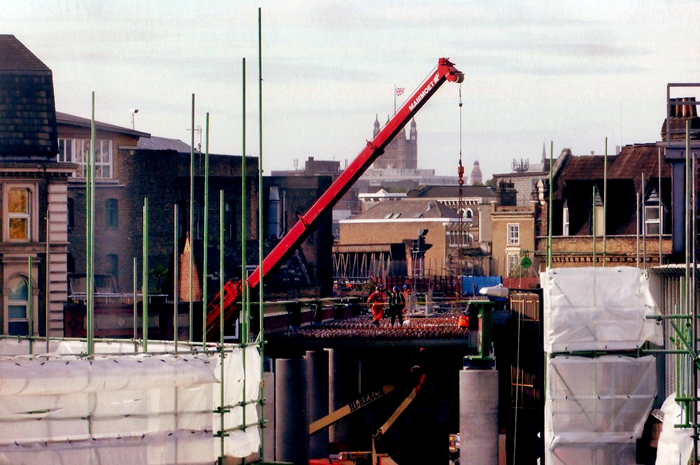
London Bridge Rebuilding Works
Thameslink Programme
The first ‘’Thameslink’’ programme was that completed in
1988, under the auspices of British Rail’s ‘’Network SouthEast’’ business
sector. This involved re-opening Snow Hill Tunnel to passenger traffic, enabling
the start of a regular cross-London service between Bedfordshire and the South
Coast. Snow Hill Tunnel runs under Smithfield Meat Market, being situated
between Farringdon and City Thameslink stations. It dates from 1866, when the
LC&DR opened an extension from Ludgate Hill to Farringdon; at the latter, the
company joined the lines of the Metropolitan Railway. Passenger services through
the tunnel had ceased as long ago as 1916, but freight continued until 1969,
after which time the route closed completely.
The then new ‘’Thameslink’’ service began on 16th May 1988, at the start of the
summer timetable, and initially comprised the following direct trains:
Bedford to Gatwick (via London Bridge or Herne Hill)
Luton to Purley (via Crystal Palace or Thornton Heath)
Cricklewood to Sevenoaks (via Catford and Swanley or Catford and Orpington)
The lion’s share of the project’s budget was spent on purpose-built Class 319
electric rolling stock, which had been equipped with dual-voltage capabilities
to run off third rail and overhead wires. By 1991, the scope of the services had
been widened to include the following:
Luton to Sevenoaks
Luton to Bromley South
Luton to Guildford (via West Croydon)
The success of the new route, which quickly saw trains running at full capacity,
provided the impetus for a second ‘’Thameslink’’ scheme. Shortly before its 1996
flotation, infrastructure owner ‘’Railtrack’’ and the Government agreed a £580
million programme of upgrades to increase capacity through Central London. This
included revised track layouts, new signals, new power distribution systems, and
the provision of a new underground station beneath St Pancras to replace the
existing Kings Cross Thameslink site. Major infrastructure works were planned
for London Bridge and Blackfriars, and new rolling stock was to be procured to
supplement the Class 319 fleet. This scheme was named ‘’Thameslink 2000’’, the
suffix indicating the intended date of completion.
By 1998, work still had not started. The capital cost of the project was revised
up to £650 million, of which the Government was committed to providing £100
million, and the date of completion was pushed back to summer 2002. The scheme
was also dependent on Phase 2 of the Channel Tunnel Rail Link going ahead;
should the latter fail, Railtrack reported that the Thameslink project would no
longer be financially viable. In addition, construction of the underground
station at St Pancras was tied in with Phase 2 of the CTRL, which meant delays
executing that project had a direct knock-on effect for Thameslink 2000. Revised
timescales now pointed to the year 2000 as the start of Thameslink works, with a
completion date of 2004. However, slow progress getting Phase 2 of the CTRL off
the ground pushed the finish line back further, this time to 2006.
To add more woes, Railtrack was plunged into crisis through a combination of the
Hatfield crash in 2000 and spiralling costs on the West Coast Main Line upgrade.
This culminated in the organisation going into administration in October 2001,
its assets being taken over by a newly-formed ‘’Network Rail’’ on 3rd October
2002.
23rd September 2009
The crane in the background of this westward view is upon the former site of ''Southwark Towers'', the 24-storey skyscraper which was demolished to make way for ''The Shard''. Behind and to the right of the crane is ''New London Bridge House'', which was also scheduled for demolition, and on the left is Guy's Hospital. © David Glasspool
23rd September 2009
Behind the trainshed, we can see the first foundations being made for ''The Shard''. This view shows to good effect the elevated nature of the platforms and tracks of the terminus station. © David Glasspool
23rd September 2009
Panning to the left (north) of the previous view, the southern limit of the existing station concourse (officially opened in 1978) is evident. One of the trainshed's columns can be seen standing precariously on the edge, on the right of this photograph. © David Glasspool
23rd September 2009
Looking Charing Cross-bound, it is evident that ''Railway Approach'' had been closed and boarded off, in preparation for work to begin on the new viaduct. © David Glasspool
4th November 2010

Charing Cross-bound once again, but this time we are up high to witness the construction of the new Borough Market Viaduct, by that time well underway. © Roger Goodrum
Return to the Kent Rail Homepage or alternatively, check for Updates.
Website & Copyright information - Links - Contact the Webmaster
All content is copyright © David Glasspool unless otherwise stated